Directory Tree Host
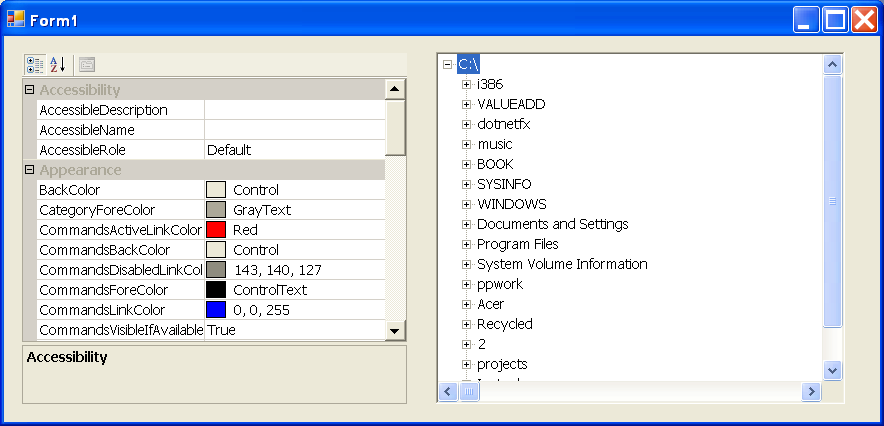
/*
User Interfaces in C#: Windows Forms and Custom Controls
by Matthew MacDonald
Publisher: Apress
ISBN: 1590590457
*/
using System.IO;
using System;
using System.Drawing;
using System.Collections;
using System.ComponentModel;
using System.Windows.Forms;
namespace DirectoryTreeHost
{
/// <summary>
/// Summary description for DirectoryTreeHost.
/// </summary>
public class DirectoryTreeHost : System.Windows.Forms.Form
{
/// <summary>
/// Required designer variable.
/// </summary>
private System.ComponentModel.Container components = null;
public DirectoryTreeHost()
{
//
// Required for Windows Form Designer support
//
InitializeComponent();
//
// TODO: Add any constructor code after InitializeComponent call
//
}
/// <summary>
/// Clean up any resources being used.
/// </summary>
protected override void Dispose( bool disposing )
{
if( disposing )
{
if(components != null)
{
components.Dispose();
}
}
base.Dispose( disposing );
}
#region Windows Form Designer generated code
/// <summary>
/// Required method for Designer support - do not modify
/// the contents of this method with the code editor.
/// </summary>
private void InitializeComponent()
{
//
// DirectoryTreeHost
//
this.AutoScaleBaseSize = new System.Drawing.Size(5, 13);
this.ClientSize = new System.Drawing.Size(292, 266);
this.Name = "DirectoryTreeHost";
this.Text = "DirectoryTreeHost";
this.Load += new System.EventHandler(this.DirectoryTreeHost_Load);
}
#endregion
private void DirectoryTreeHost_Load(object sender, System.EventArgs e)
{
DirectoryTree dirTree = new
DirectoryTree();
dirTree.Size = new Size(this.Width - 30, this.Height - 60);
dirTree.Location = new Point(5, 5);
dirTree.Drive = Char.Parse("C");
this.Controls.Add(dirTree);
}
public static void Main()
{
Application.Run(new DirectoryTreeHost());
}
}
public class DirectoryTree : TreeView
{
public delegate void DirectorySelectedDelegate(object sender,
DirectorySelectedEventArgs e);
public event DirectorySelectedDelegate DirectorySelected;
private Char drive;
public Char Drive
{
get
{
return drive;
}
set
{
drive = value;
RefreshDisplay();
}
}
// This is public so a Refresh can be triggered manually.
public void RefreshDisplay()
{
// Erase the existing tree.
this.Nodes.Clear();
// Set the first node.
TreeNode rootNode = new TreeNode(drive + ":\\");
this.Nodes.Add(rootNode);
// Fill the first level and expand it.
Fill(rootNode);
this.Nodes[0].Expand();
}
private void Fill(TreeNode dirNode)
{
DirectoryInfo dir = new DirectoryInfo(dirNode.FullPath);
// An exception could be thrown in this code if you don't
// have sufficient security permissions for a file or directory.
// You can catch and then ignore this exception.
foreach (DirectoryInfo dirItem in dir.GetDirectories())
{
// Add node for the directory.
TreeNode newNode = new TreeNode(dirItem.Name);
dirNode.Nodes.Add(newNode);
newNode.Nodes.Add("*");
}
}
protected override void OnBeforeExpand(TreeViewCancelEventArgs e)
{
base.OnBeforeExpand(e);
// If a dummy node is found, remove it and read the real directory list.
if (e.Node.Nodes[0].Text == "*")
{
e.Node.Nodes.Clear();
Fill(e.Node);
}
}
protected override void OnAfterSelect(TreeViewEventArgs e)
{
base.OnAfterSelect(e);
// Raise the DirectorySelected event.
if (DirectorySelected != null)
{
DirectorySelected(this,
new DirectorySelectedEventArgs(e.Node.FullPath));
}
}
}
public class DirectorySelectedEventArgs : EventArgs
{
public string DirectoryName;
public DirectorySelectedEventArgs(string directoryName)
{
this.DirectoryName = directoryName;
}
}
}
Related examples in the same category
| 1. | Find Files That Match a Wildcard Expression | | |
| 2. | Get Files from a directory | | |
| 3. | Get Directory properties from DirectionInfo class | | |
| 4. | Get directory name and file information in that directory | | |
| 5. | Directory Counter | | |
| 6. | File Search | | |
| 7. | Get Name, Parent, Exists properties from DirectoryInfo class | | |
| 8. | Get Creation Time | | |
| 9. | Get Last Write Time | | |
| 10. | Get Last Access Time | | |
| 11. | Calculate Directory Size | | |
| 12. | Copy Directory | | |
| 13. | Check the Existance of a Directory | | |
| 14. | Get Current Directory | | |
| 15. | Set Current Directory | | |
| 16. | Traversing Directories | | 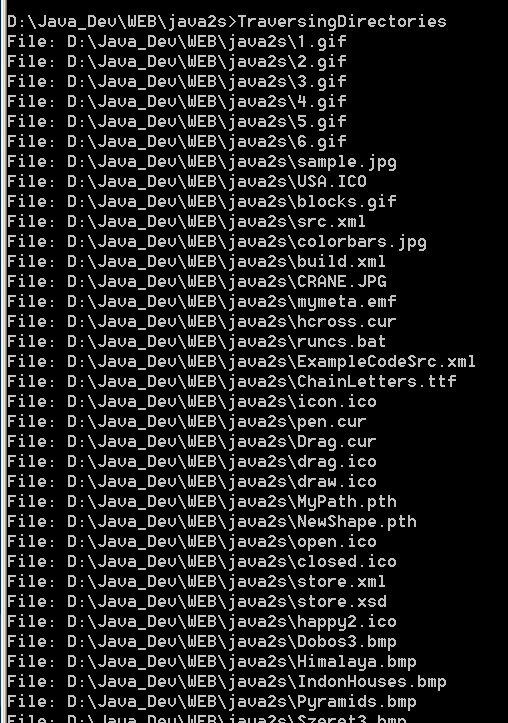 |
| 17. | Directory Object | | |
| 18. | illustrates recursive Directory use | | 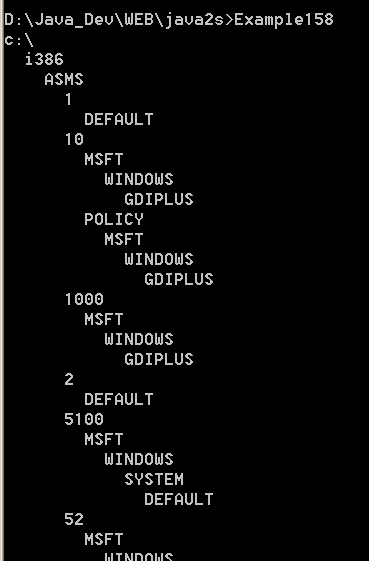 |
| 19. | illustrates the Directory class | |  |
| 20. | illustrates the Directory class 2 | | 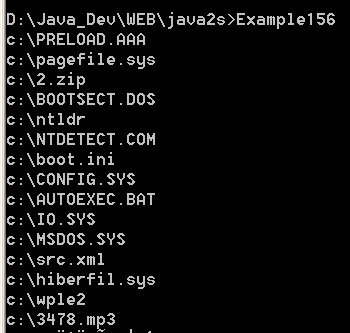 |
| 21. | Uses the DirectoryInfo class to recursively show subdirectories | | 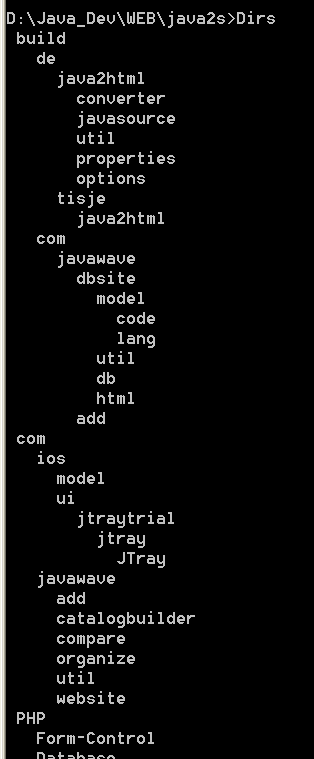 |
| 22. | Changes the current working directory and then lists the files in the directory | | 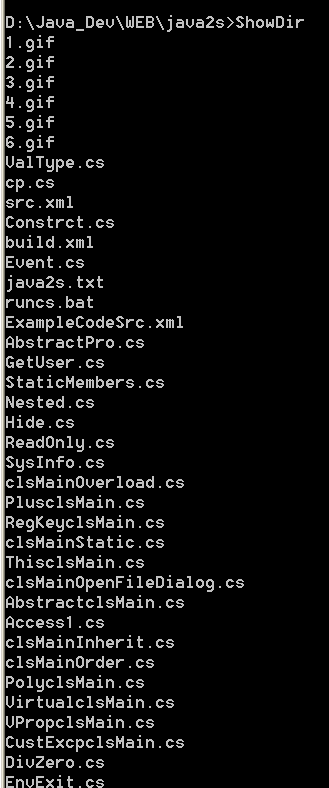 |
| 23. | Gets the size of all files within a directory | | |
| 24. | Determine if the directory is empty, ie. no files and no sub-directories | | |
| 25. | Get an array of files info from a directory. | | |
| 26. | Removes a directory as best as it can. Errors are ignored. | | |
| 27. | Directory Class xxposes static methods for creating, moving, and enumerating through directories and subdirectories. | | |
| 28. | Calculates the size of a directory and its subdirectories, if any, and displays the total size in bytes. | | |
| 29. | Gets the current working directory of the application. | | |
| 30. | Directory Class | | |
| 31. | Calculate the size of a directory and its subdirectories, if any, and displays the total size in bytes. | | |
| 32. | Creates all directories and subdirectories in the specified path. | | |
| 33. | Create new nested directories | | |
| 34. | Deletes an empty directory from a specified path. | | |
| 35. | Deletes the directory any subdirectories and files in the directory. | | |
| 36. | Returns an enumerable collection of directory names in a specified path. | | |
| 37. | Returns an enumerable collection of directory names that match a search pattern in a specified path. | | |
| 38. | Get collection of directory names that match a search pattern, and optionally searches subdirectories. | | |
| 39. | Returns an enumerable collection of file names in a specified path. | | |
| 40. | Returns an enumerable collection of file names that match a search pattern in a specified path. | | |
| 41. | Get a collection of file names that match a search pattern, and optionally searches subdirectories. | | |
| 42. | Determines whether the given path refers to an existing directory on disk. | | |
| 43. | Gets a DirectorySecurity object that encapsulates the access control list (ACL) entries | | |
| 44. | Gets the creation date and time of a directory. | | |
| 45. | Gets the creation date and time, in Coordinated Universal Time (UTC) format, of a directory. | | |
| 46. | Gets the names of subdirectories in the specified directory. | | |
| 47. | Gets an array of directories matching the specified search pattern from the current directory. | | |
| 48. | Returns the volume information, root information, or both for the specified path. | | |
| 49. | Returns the names of files that match the specified search pattern | | |
| 50. | Returns the names of all files and subdirectories in the specified directory. | | |
| 51. | Returns the date and time the specified file or directory was last accessed. | | |
| 52. | Returns the date and time the specified file or directory was last written to. | | |
| 53. | Sets the date and time the specified file or directory was last accessed. | | |
| 54. | Sets the date and time a directory was last written to. | | |
| 55. | Instance methods for creating, moving, and enumerating through directories and subdirectories. | | |
| 56. | Copy directories with DirectoryInfo | | |
| 57. | DriveInfo Class Provides access to information on a drive. | | |
| 58. | Read and Write to a Newly Created Data File | | |
| 59. | Read Text from a File | | |
| 60. | File.OpenText returns a StreamReader | | |
| 61. | Write Text to a File | | |
| 62. | Copy,delete file and directory | | |
| 63. | Find all files in a directory, and all files within every nested directory. | | |
| 64. | Find all files in a directory, and all files within every nested directory. (2) | | |
| 65. | Current Dir | | |
| 66. | Directory Walker | | |
| 67. | Create Directory | | |
| 68. | Class, which describes folder with its subfolders. | | |